

 The Accurate Reloading Forums
The Accurate Reloading Forums  THE ACCURATE RELOADING.COM FORUMS
THE ACCURATE RELOADING.COM FORUMS  Guns, Politics, Gunsmithing & Reloading
Guns, Politics, Gunsmithing & Reloading  Military & Military Surplus
Military & Military Surplus  Surplus 38 Spec. Velocity
Surplus 38 Spec. VelocityGo  | New  | Find  | Notify  | Tools  | Reply  |  |
| new member |
I just finished a two day job of bringing home a great find from a garage sale setting up in the little town just west of me, a "haul" of surplus 38 Spec. with the headstamp R A 66. I had seen this in Vietnam in 1967 as this is the ammo that was issued to us for the junk, rattly S&W Combat Masterpiece 38 Spec. revolvers that Army Huey pilots carried. The lady having the garage sale was being helped by her daughter and my neighbor's wife. My neighbor told me about the ammo and I drove up the hill to check it out. It was in a late 1950's bomb shelter in what would be a 3rd basement. 25,000 rounds in the original boxes on some of the heaviest shelving I have ever seen. All the boxes except one were still sealed. The lady's daughter said if I was willing to haul it up 3 flights of stairs, it and the shelves were mine. No brainier, right. After cooling off and thinking a little last night, I started to see what I could find out about this stuff. I know it has a 130gr. full metal jacket bullet, but now idea as to velocity. I do remember it seemed anemic at the time. Anybody know anything more about this stuff? Thanks | ||
|
| one of us |
I don't know what velocity that stuff has, but I shot a couple of thousand rounds of that stuff in the 70's. You're correct in the "anemic" loading. I remember that the velocity was around the same as "target loads". And, it was fairly accurate at 25 yds. from a revolver. Have the ammo chrono'd. There's really not much that you can do about it, except to enjoy a lifetime of shooting and plinking. Shooter | |||
|
| one of us |
Heck a life time maybe 5 to 10 years worth of paractice. | |||
|
| new member |
A friend of mine with a chronograph took a box of the ammo and my 6" GP100 to the range last Friday and shot them for velocity. He got an average of 797fps from the 6" barrel. He shot some through his Marlin 1894 with an 18" or 20" barrel and got an average of 1206fps. With my Marlin 1894 Cowboy with a 24" barrel he only got another 75fps out of the extra 4" of barrel. He said in my Marlin with its full octagon barrel there was not enough recoil to even call it that. My grandkids are going to have a lot of good shooting and good marksmanship training with these anemic rounds. The lack of recoil will help this. | |||
|
| One of Us |
Why does the ammo have to be "hot"? There is only one way to teach precision shooting for accuracy, and that is with ammunition that is accurate enough to give the shooter the right feedback, and not be so vigorous in recoil that the shooter becomes afraid of the revolver. I think what you have is perfect for teaching new revolver shooters the art of "putting them in the same hole"... | |||
|
| One of Us |
if i remember right it was supposed to give 830fps. but that is about the best brass you can ever find | |||
|
| One of Us |
I went through several hundred rounds of this in the 80's. Seems that I experienced quite a few pierced primers. Didn't happen with other lots of 3-D wadcutters. Dutch | |||
|
| one of us |
Strange... Just earlier today I was rumminging around looking for something and came across a full box of, BALL CALIBER .38 M41 loaded by WCC headstamped WCC 72. I shot a few thousand rounds of this stuff back in the early to mid 1970's. There is actually 2 versions of 38 Special M41 ammo. Going from memory... The first was adopted in the mid 1950's. by the Air Force. It had a 130gr FMJ bullet loaded at low pressure @13,000 psi for the aluminium cylindered revolvers, that were cracking cylinders with normal 38 ammo. The velocity was @ 730 from a 4" revolver. Later @ 1961 the M41 was changed to a pressure of @ 16,000 psi which boosted velocity to @750fps in a 4" revolver. The Aluminium cylinders being long gone by this time... I never had any issues shooting this 38 Special ammo in a wide variety of 38 Special and 357 Mag revolvers. I was able to get it at a very good price at the time. Fish Bait Check all of your ammo and see if any of it is marked PGU-12/B. This is higher pressure, @20,000psi with a velocity of @950fps in a 4" revolver, if I remember correctly. DOUBLE RIFLE SHOOTERS SOCIETY | |||
|
| new member |
I finally got all the heavy shelving assembled and stacked all the ammo. Every box is Remington and after opening who knows how many just to check, it is all headstamped R A 66. The cardboard boxes it came in with 10 50 round/boxes each also have U. S. Army Ordinance and the "bomb" symbol. | |||
|
| One of Us |
Being stored in a basement this stuff was kept in a cool environment . This is good. But don’t kid yourself that 46 year old ammunition is new or that it will last another 46 years. Ammunition has a shelf life, due to gunpowder deterioration. The rule of thumb for safe lifetime is 20 years for double based and 45 years for single based. Heat reduces the shelf life. Shoot it up before you get squibs, pressure problems. | |||
|
| one of us |
If nothing else sell it off a little at a time at gun shows, online, face to face. Then use the cash to buy whatever you want. Either way you hit the lottery. Great find. There will also be some collectors who will jump on sealed containers so do not open all of them. Happiness is a warm gun | |||
|
| one of us |
That might be a general rule of thumb but I have several hundred rounds of 303 Brit dated 1917 that still shoots at full power. I pull a few stripper clips (it came in light cotton bandoliers, two strippers to a pocket) every year and chrongraph some. No change since I bought the lot in the 80s. "Experience" is the only class you take where the exam comes before the lesson. | |||
|
| One of Us |
Would you eat a ninety six year old twinkie? You bought a large amount of old WW1 ammunition thirty years ago and you are wishing it will last your lifetime. Well I clapped my hands for tinker bell as a kid but that does not make faires real. Physics has not changed much since WW1 and one of the things that stays true is that nitrocellulose is a high energy molecule that is breaking down to a lower energy molecule from the day it leaves the factory. There are many reasons why the military tests its ammunition stockpile and flushes the stuff out of its system. I found this document, which is the meeting minutes between Nato Insensitive Munitions experts. I found the Bulgarian presentation the most useful for any discussion on the shelf life of small arms ammunition. Just look at who many tons of old ammunition they have to junk. http://www.underwatermunitions..._disposal_-_NATO.pdf Environmental Impact of Munition and Propellant Disposal
I have no qualms about people shooting up old ammunition. Just don’t do it near me. I warned you, you can Google “insensitive munitions” and find out that ammunition gets dangerous and unpredictable with age. You can find out that guns blow up with old ammunition, and after all that , if you want to shoot the stuff, you have been informed of the risks. | |||
|
| One of Us |
Slamfire you have little experience with old ammo. | |||
|
| one of us |
Having read through most it is dealing with disposel not life expectancy. Then 13 percent of their dealings was small arms ammo. The rest much larger expolsives. Citing this study really has nothing to do with the age of the will stored small ams ammo. | |||
|
| one of us |
He doesn't tolerate dissent well, either. I hear that's often the case with twinkies and faires. "Experience" is the only class you take where the exam comes before the lesson. | |||
|
| one of us |
I was a marksmanship instructor with the U.S. Air Force during the late sixties and early seventies. Yes the early ammo was poor in velocity, but accurate. The PGU12/B ammo was a combat round that would chrono out of 4" S&W Model 15 Combat Msterpieces from 800 to 850 fps depending on lot number. The brass would last forever if standard velocity loads were used. .395 Family Member DRSS, po' boy member Political correctness is nothing but liberal enforced censorship | |||
|
| one of us |
Can you reference ONE verified instance of a personal firearm blowing up due to the use of old ammunition? xxxxxxxxxx When considering US based operations of guides/outfitters, check and see if they are NRA members. If not, why support someone who doesn't support us? Consider spending your money elsewhere. NEVER, EVER book a hunt with BLAIR WORLDWIDE HUNTING or JEFF BLAIR. I have come to understand that in hunting, the goal is not the goal but the process. | |||
|
| One of Us |
http://www.socnet.com/showthread.php?p=1344088 This is the best account I have, complete with pictures. People blow up firearms all the time, very few understand that old ammunition is risky, and even less want to talk about it. I wish there was statistics on how many old rockets have blown up due to solid propellant instability, but there are bunches.
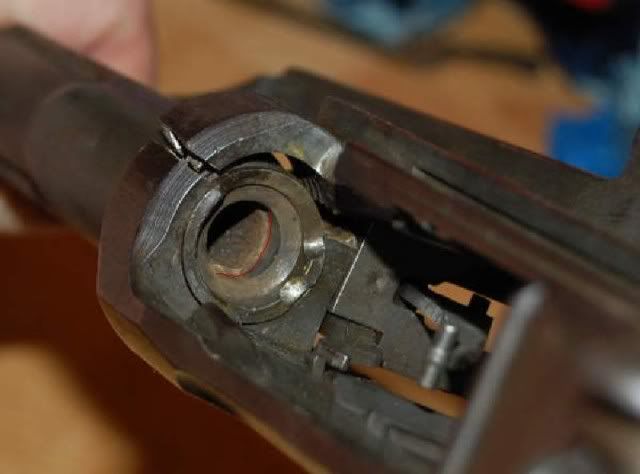 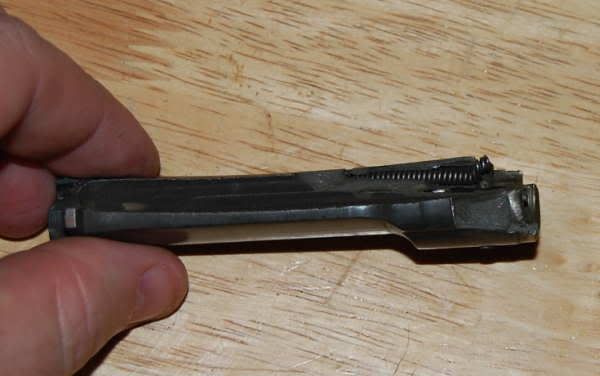 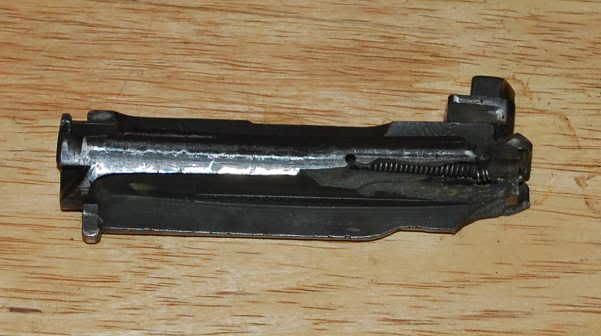 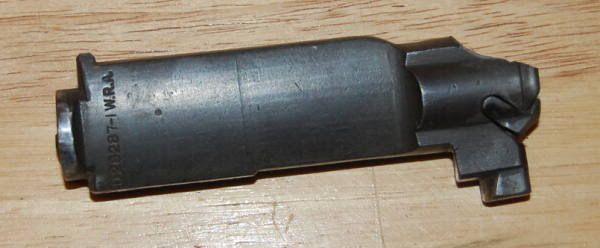 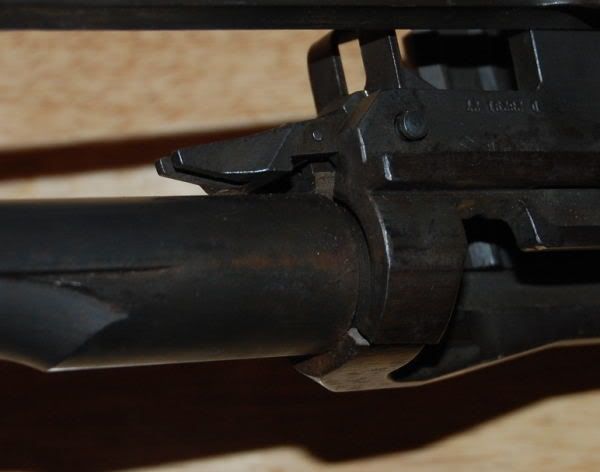 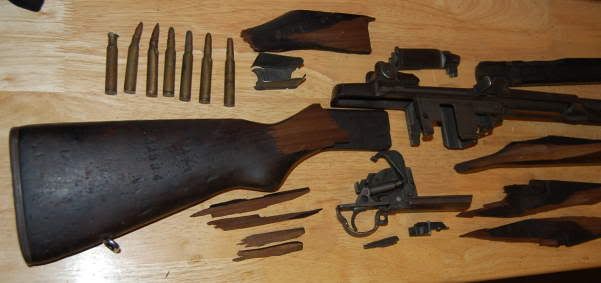 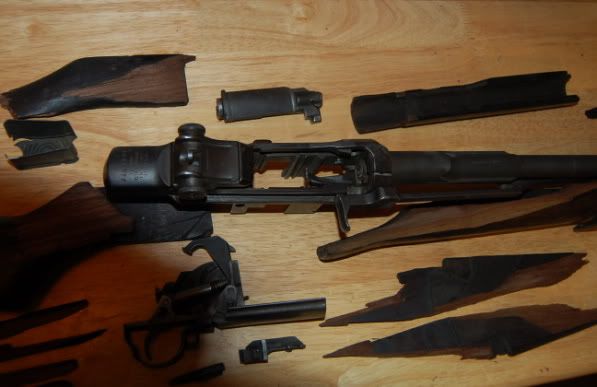 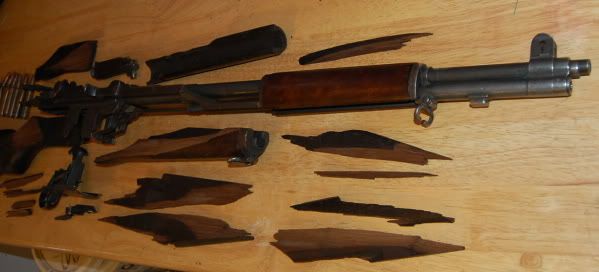 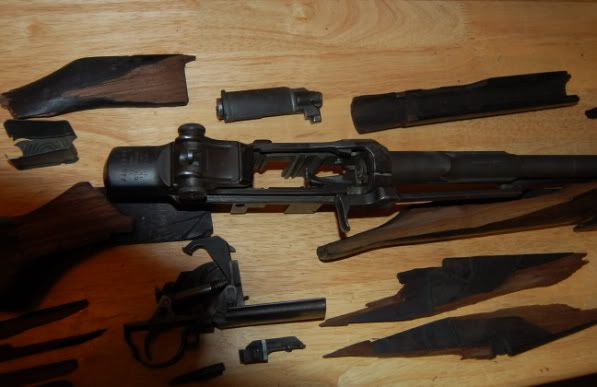 | |||
|
| one of us |
Most grands get taken apart like that from out of battery firing. Normmaly a defective firearm then ammo. Looking at the damage amount of case left in the chamber the sheared off lockings out of battery. Seen it before. Very hard to prove one way or the other | |||
|
| One of Us |
Left lug was engaged and sheared through the bolt body, that is how you know the bolt was in battery. Plus it was on the first chambered round. The hammer nose on the Garand prevents the hammer from hitting the firing pin until the lugs are in battery. And they disassembled rounds and found dusty and clumped powder. That is 100% positive indication of deteriorated gunpowder. As it was explained to me by an insensitive munitions expert, as gunpowder deteriorates the powder grain deteriorates unevenly. Instead of a nice smooth pressure curve the pressure curve becomes irregular. This is bad. Worse, with double based powders the nitroglycerine migrates to the surface, spiking the burn rate. I was told that the surface of old ordnance charges becomes sensitized with age, someone moves the stuff, friction happens, kaboom! ROLE OF DIPHENYLAMINE AS A STABILIZER IN PROPELLANTS; ANALYTICAL CHEMISTRY OF DIPHENYLAMINE IN PROPELLANTS
http://www.dtic.mil/dtic/tr/fulltext/u2/783499.pdf Heat, as you can see in the report, will age gunpowder. Heat is bad.  Combustion pressures will rise after high temperature storage.
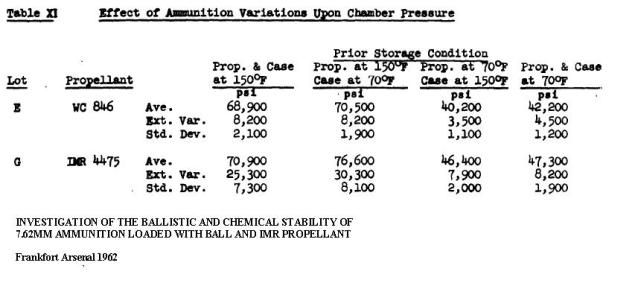
That report was the meeting minutes of experts and what must be done to prevent ammo dumps from exploding. I did think it was interesting because of the Bulgarian numbers. I have only heard of the US numbers for propellant shelf life. Maybe it was just too high a level for the people on this forum. Play with the number: 13% by weight and 98% by volume:
So why are the Bulgarian's disposing of 76,100 tones of Ordnance, 98% volume percent small arms ammunition, if it lasts forever? Remember from your readings they said it is not acceptable for use, not that they are no longer using that calibers. So it if lasts forever, why not keep it and use it in training? In so far as “explosives”. What propellant technology is used inside artillery shells, rocket motors, small arms ammunition, explosive warheads? Are the laws of physics different for an identical propellant if it is inside a rocket, artillery shell, verses a rifle round? Come on twinkies and faires, why?
I am just waiting to read your experience and knowledge.
You are free to do your own research and get educated on this topic. I respect those who do the hard work of getting educated, finding knowledge, having experiences to share. Ignorance is the natural state of mankind. It takes work, hard work, to learn, to explore, to increase the boundaries of your knowledge; it takes nothing to stay ignorant. Nothing. If all you have is ignorance and sarcasm don’t expect me to kowtow to you. | |||
|
| One of Us |
M1s are known to slam fire from defective firing pins. Second you have not really provided any real reason this man's lot of ammo should be suspect. All you have done is quote a lot of unrelated stuff. So now you tell us the real way to find out what is going on with the ammo.... Got no idea? Well you take a statistically valid sample and shoot it. If it is ok proceed with shooting it for recreation or whatever. As you shoot more of it your sample just grows larger and more statistically valid. After a few thousand rounds he can tell you more about the ammo than all the stuff you cut and paste from the net because it is dealing with the actual ammo and not something someone else did. Now start kowtowing. | |||
|
| One of Us |
Sure. Why would the rifle blow up from an in battery slamfire? I have had them in Garands and AR15's. I have been giving people a warning about the risks of old ammunition. The stuff is not risk free, it gets worse with age. That is not what the “experts” on this page have said. Everyone is shooting WW1 ammunition if not older. Ammunition last forever, perfectly safe, never goes bad. And you don’t want to hear otherwise. Sitting on your pile of old ammunition, thinking it will last forever, or at least as long as you. You can advise people to shoot enough ammunition and see if the gun blows up. If the gun does not blow up than the ammunition was safe. If the gun blows up then the ammunition was unsafe. That is one way to do it. If you don’t understand the chemistry or the kinetics just shoot until your hand/head is detached from your body by a bad round. Works every time and is a 100% indication of unsafe ammunition. I look for the gross indications of age. Old gunpowder outgasses NOx. I have pulled bullets, looked for corrosion, look for cracked case necks, and I have seen how the ES’s and SD’s increase with old ammunition. Evidence of squibs and huge fireballs are positive indications of age. The best thing to do after those physical observations is pull the bullets and dump the powder, examine cases for corrosion. Once I learned about the problems with old propellant, I poured out over 75% of the surplus powders I bought. They were bad, they went bad. I got pressure indications or evidence of outgassing, like the photographs below. NOx attacks brass, causes it to fail. This 303 Case was corroded. I am not going to shoot it due to concerns how the corrosion weakens the case, so I pulled the bullet to see evidence of corrosion. I don’t know whether the coridite has changed color, but I did not see evidence of internal pitting. 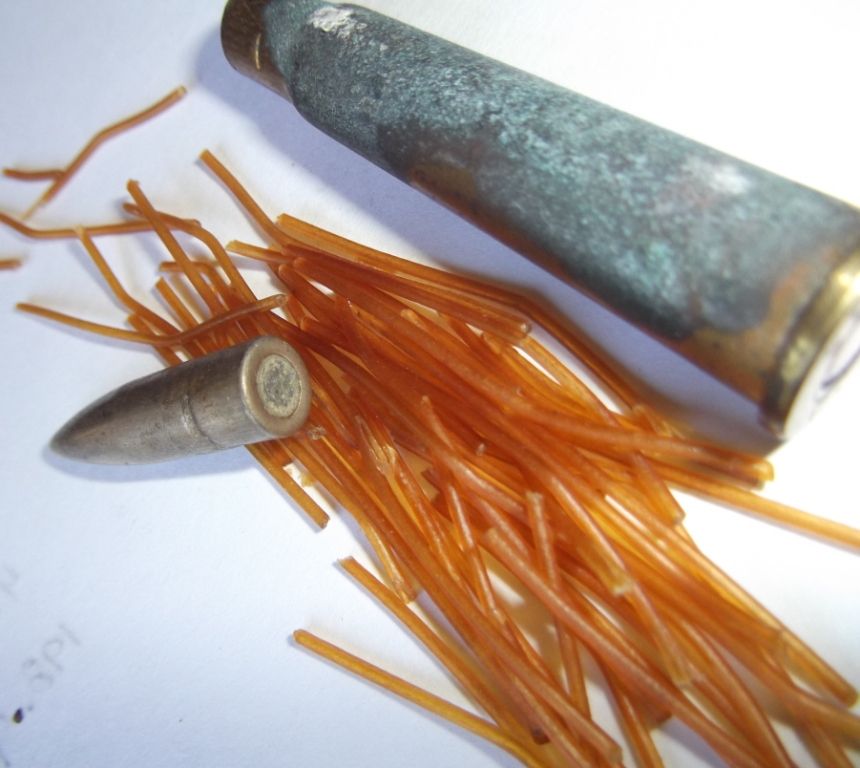 All of these Nov 1898 Krag 30-40 cases had case neck cracks. I pulled the bullet and found that the powder was red. This stuff should not be fired . 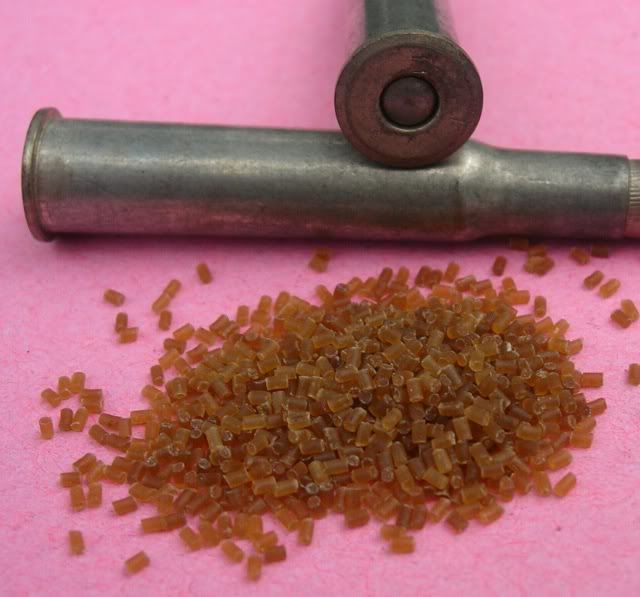 I am no longer buying loaded old military surplus. The stuff was rejected as unfit by the procuring agency. I am not buying old estate sale powders anymore. I am shooting up my oldest powders first. I went to the Library this week doing more research on the topic of moisture effects on single and double based propellants. For my own edification. What research have any of my critics done? What do you know on this topic other than what I have told you? Tell me something new.  | |||
|
| one of us |
Send me all the old ammo anyone does not want. I will be happy to deal with it. Happiness is a warm gun | |||
|
| one of us |
One thing to think of, is eventually that the surplus ammo will run out, if the hoplophobes don't grab the "bolt action assault rifles" first. I have noticed the Serbs (?Yugo?) still producing 8x57mm military ammo, some as late as 1999 dates. The PPU ammo, also Serb as well, is produced in several military calibers that are normally only found as surplus - so if there are those that don't want to shoot ancient stored ammo they can go to this. I get 8x57 and 303 British this way that isn't as expensive as Winchester Super-X. That and it doesn't seem to be under the same heavy demand as 5.56x45, 7.62x39, 7.62x51, etc. sputster | |||
|
| One of Us |
I thought I would post these images from some very old Safety Reports. The first one is from 1969 and the second from 1970. Forty four and 43 years ago the ammunition surveillance experts were reporting that certain WW2 30 Caliber ball (then 27 years old) were too dangerous to keep in inventory. As you can see they decided this upon fume tests, which is a test of the amount of stabilizer left in the powder. What makes anyone think that the surplus ammunition you bought is somehow new or as good as new? Don’t you think that the safety experts ran tests on the stuff before selling it off to you? After getting your money, don’t you think they laughed all the way to the bank? And do you really think WW2 era ammunition has gotten better in the last 44 years? 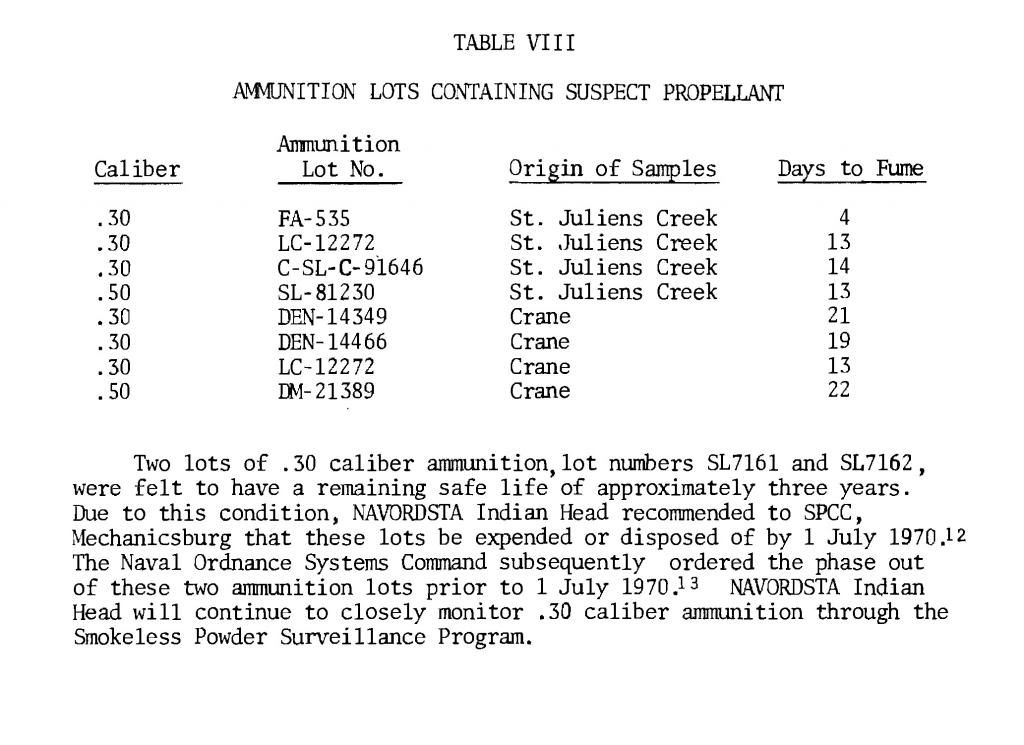 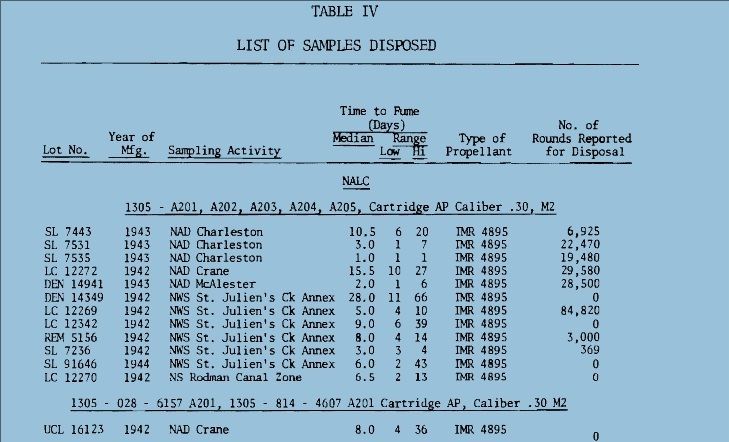 | |||
|
| One of Us |
I would like to update this thread with this account of an over pressure cartridge loaded with old deteriorated gunpowder. http://www.thehighroad.org/sho...=7756780&postcount=6
| |||
|
| one of us |
Interesting... I guess I haven't researched this stuff much, but is there any way to visually inspect modern smokeless powder to see the deterioration you describe? I've seen blackpowder that gets "clumpy" from poor (humidity?) storage, but wondering how smokeless powder reacts to like conditions... Is there a "litmus test" so to speak? | |||
|
| One of Us |
Interesting... I guess I haven't researched this stuff much, but is there any way to visually inspect modern smokeless powder to see the deterioration you describe? I've seen blackpowder that gets "clumpy" from poor (humidity?) storage, but wondering how smokeless powder reacts to like conditions... Is there a "litmus test" so to speak? Yes there is a litmus test, and it is conducted with methyl violet paper. I was told inspectors put methy violet paper in a test tube with a sample of powder. I don’t remember the time, but if the paper turns pink the powder is then tested for stabilizer content. There are a lot of powder tests, and they require a chemistry lab. Take a look at Mil C 286C Propellants Solid, Sampling, Examination and Testing http://www.everyspec.com/MIL-S...9/MIL-STD-286C_8618/ For us who do not have a chemistry lab, all you can really tell is the gross indications of powder that is way past its shelf life. Pull a few bullets and see if there is green corrosion in the case and on the bottom of the bullets. If so, the powder is severely outgassing NOx indicating depletion of the stabilizer. 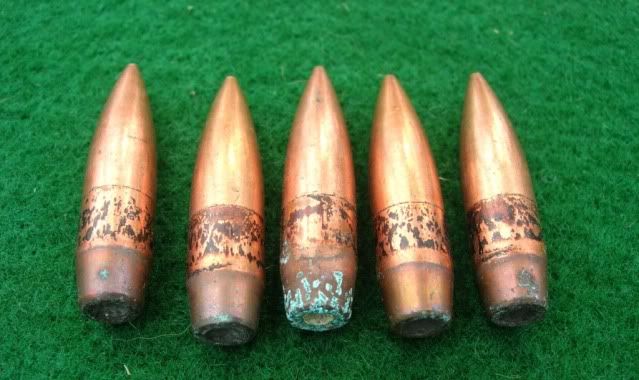 The red color change in the picture above. Fuming nitric acid will positively knock your socks off if you smell it. So a bitter smell with red dust is a positive indication of old powder. The nitrogylcerine in double based powders migrate to the surface, maybe that accounts for the glumpy issues. I would say anything that changes the composition, color, smell, free flowing characteritics of powder is a clue that it is old. | |||
|
| Powered by Social Strata |
| Please Wait. Your request is being processed... |
|

Visit our on-line store for AR Memorabilia

